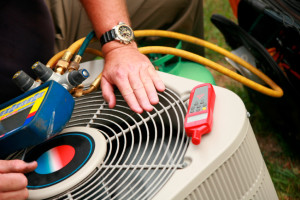 The refrigeration cycle isn’t just something that keeps the ice cream from melting in your kitchen freezer. Utilized by your central air conditioner, the refrigeration cycle extracts heat energy from inside your house and moves it outdoors. Though the first air conditioner was invented in 1902, the underlying theory of the refrigeration cycle remains the same today.
The refrigeration cycle isn’t just something that keeps the ice cream from melting in your kitchen freezer. Utilized by your central air conditioner, the refrigeration cycle extracts heat energy from inside your house and moves it outdoors. Though the first air conditioner was invented in 1902, the underlying theory of the refrigeration cycle remains the same today.
How the Refrigeration Cycle Works
A chemical called refrigerant continuously circulates between the indoor and outdoor components of your central A/C. Refrigerant shifts from a cold vapor to a hot liquid under pressure. As it evaporates into a frigid vapor at just 40 degrees Fahrenheit, refrigerant is a highly efficient heat-absorber. Condensing into a hot liquid under pressure, it becomes a heat-releaser. These amazing properties form the basis for the refrigeration cycle that takes heat out of your home. Here’s the general sequence of events.
Evaporator Coil
Entering the copper tubing of the evaporator coil in your indoor air handler, refrigerant evaporates into a cold, vaporous state. As the system blower pulls warm indoor air through coil air passages, heat energy in the air is absorbed by the frigid refrigerant vapor. Cooled air leaving the opposite side of the coil enters the supply ductwork and is dispersed throughout your home.
Condenser
Refrigerant flows from the indoor evaporator to the outdoor condenser where a compressor pressurizes the flow, concentrating molecules of heat energy and converting the vapor to a super-hot gas. As the heated, pressurized gas refrigerant enters the outdoor coil, it rapidly condenses to a liquid state, shedding its concentrated heat energy. Heat-dispersing fins attached to the condenser coil release heat and the coil fan blows it into the outdoor air.
There and Back Again
Circling back to the evaporator coil, the liquid refrigerant flow passes through an expansion valve that converts it again to a vaporous state, ready to absorb more heat from your home.
To learn more about how the refrigerant cycle keeps you cool, check out Senica Air Conditioning, Inc.’s A/C solutions or call 866-881-5935.



